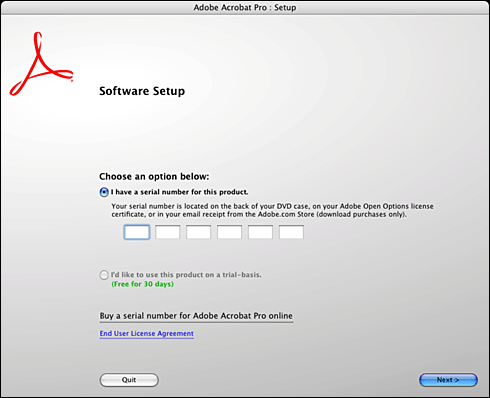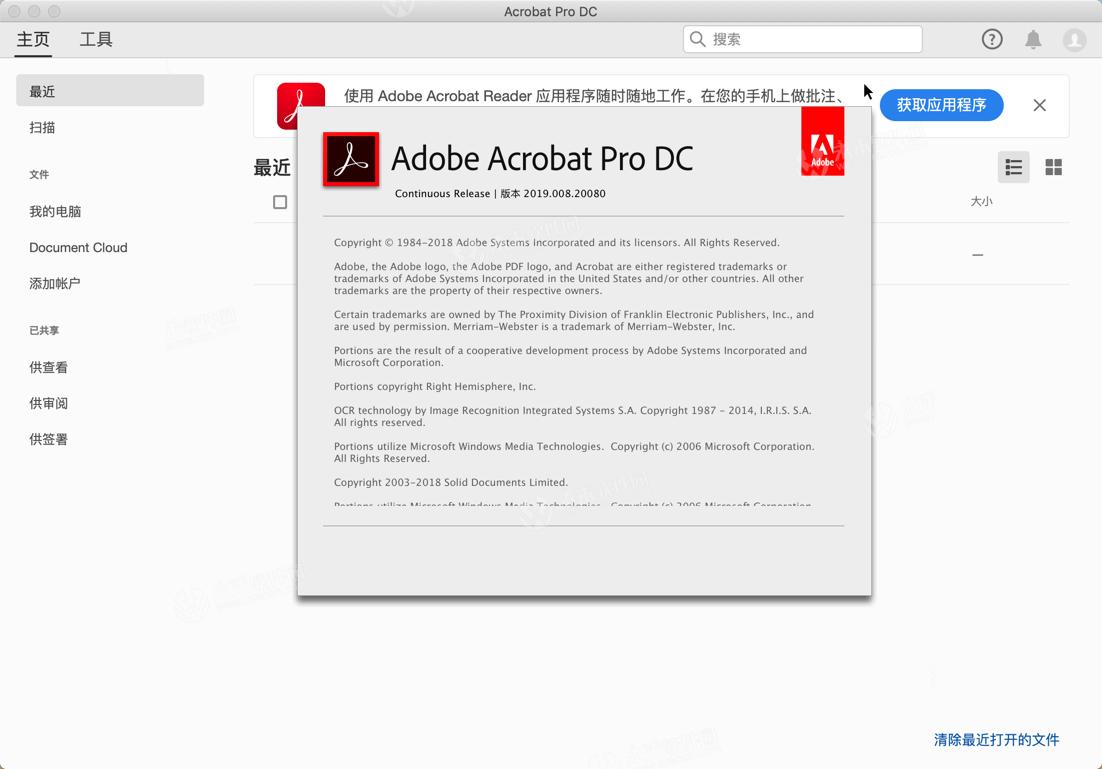Download and get free Mac Adobe Acrobat XI Pro 11 for OS X with full crack/. Phn mm Adobe Acrobat XI Pro (Full Crack), i vi nhng ngi. I am trying to install Adobe Acrobat XI Pro version 11.0.07 of which originally I purchased a license. But, The installation can not be in progress in MacOS Catalina version 10.15 even being failed Adobe Acrobat XI Pro version 11.0.23. Adobe Acrobat Pro DC 2018 Crack Mac, Adobe Acrobat Pro DC 2018 Full Crack, Adobe Acrobat Pro DC 2018 Free Download, Adobe Acrobat Pro DC 2018 Patch.
Windows¶
Note
The AcroCleaner is not an uninstaller and should NOT be used as such. Adobe provides the utility as a least resort to repair machines after a failed or partial uninstall. Always uninstall DC products via standard, supported methods.
The Adobe Reader and Acrobat Cleaner Tool removes a standalone installation of Reader or Acrobat, including any leftover preferences and settings remaining after a standard program uninstall.
While most installs, uninstalls, and updates operations happen without incident, there are cases where a user may not be able to complete such tasks due to some registry or file conflict on the machine. This is particularly problematic when permissions set on plist entries or files prevent the successful installation of new installs and/or updates. The cleaner tool fixes such issues by cleaning up corrupted installations, removing or fixing corrupted files, removing or changing permissions registry entries, etc.
Note the following:

The tool provides options for removing problematic Acrobat items only while leaving Reader untouched and vice versa.
The tool cannot be used with any Creative Cloud products or Acrobat delivered with CS products. It can only be used for standalone versions of Acrobat and Reader.
In some scenarios, the cleaner tool for Windows might affect some preferences common between Acrobat and Reader. Therefore, when both Acrobat and Reader products are installed on machine, Adobe recommends the remaining installed product be repaired after running the cleaner Tool.
Downloads¶
By downloading the software listed below, I acknowledge that I have read and agreed to the terms of the Adobe PDF Test Toolkit License, the Adobe.com Terms of Use and the Adobe Online Privacy Policy.
The following is available for Acrobat and Reader (the Cleaner works with both apps):

Feb 9, 2021: 64-bit installer, all tracks. NOTE: Because Acrobat and Reader are delivered via a single installer for the 64-bit release, the Cleaner user interface only shows the ‘Acrobat’ string even when being used with Reader.
User interface usage¶
Verify you have run the product uninstaller. The Cleaner tool is NOT an uninstaller.
Double click the cleaner exe file.
Verify you want to continue, and choose Next.
Accept the EULA and choose Next.
Choose the standalone product to clean and choose Next.
Note
If the product is not found, then Acrobat/Reader is cleaned from the default installation location at ProgramFilesFolderAdobeAcrobat*.* folder. The user is also given an option to select and add any other additional installation.
If more than one product is detected, choose which product to remove and whether or not to remove any files that may be shared between Adobe Reader and Acrobat.
Choose Clean Now. Cleanup begins.
When finished, restart the machine.
Command line usage¶
Open a command prompt.
Run the tool with the command line parameters as shown below.
When finished, restart the machine.
Properties¶
ProductId: Identifies the product:
0 = Acrobat (Default)
1 = Reader
InstallPath: Specifies the product installation path. Default = the product’s default location; e.g. C:Program Files (x86)AdobeReader (version). You must use this parameter when using ScanForOthers = 0.
CleanLevel: Specifies the level of cleanup; i.e. shared components should be cleaned or not:
0 (Default) = clean only components for the selected product.
1 = clean components for the selected product as well as shared components.
ScanForOthers: Specifies whether to search for and delete only the installation directory identified by InstallPath or all directories on the machine:
0 = Search for and delete only directories found on the path specified by the InstallPath parameter.
1 (Default) = Search for and delete installation directories system wide. This search includes non-default paths as well as default paths such as C:Program FilesAdobeAcrobat 10.0.
/?: Invokes the tool’s Help; for example:
AdbeArCleaner.exe/?
Adobe Acrobat X For Mac
Macintosh¶
Usage¶
Verify you have run the product uninstaller. The Cleaner tool is NOT an uninstaller.
Double click to mount the AdobeAcroCleanerTool.dmg
Double click the file: AcroCleanerTool.app
Verify you want to continue, and choose Next.
Accept the EULA and choose Next.
Choose the product to remove and click Next.
Applications found installed are listed separately for both Acrobat and Reader. By default, all the listed applications will be selected for clean-up. Following buttons below the lists can be used to customize the list.
Remove button: Select the application you don’t want to uninstall and click ‘Remove’ button below that particular list.
Refresh button: You can repopulate the full list again using ‘Refresh’ button below that particular list.
Click the Clean button to remove the listed applications.
Press OK to confirm.
Provide an admin password in the admin prompt dialog. Cleanup processing begins.
When complete, press OK.
Press Quit to quit the app or choose View Log.
Known issues¶
If you have both Acrobat and Reader installed, removing the product that is the default PDF viewer can result in the other product failing to become the new default PDF viewer. When this problem occurs, run Repair on the remaining product and reboot the machine to make the remaining product the default PDF handler.
For Acrobat Pro Extended 9.x, the tool leaves the Acrobat entry in Add Remove Programs. To manually remove this entry, run an uninstallation from the ARP entry or manually remove the following registry entries:
Windows 32 Bit OS: HKLMSOFTWAREMicrosoftWindowsCurrentVersionUninstall<Product-Code>
Windows 64 Bit OS: HKLMSOFTWAREWow6432NodeMicrosoftWindowsCurrentVersionUninstall<Product-Code>
The product code is language specific. For example, for EFG it would be {AC76BA86-1033-F400-7761-000000000004}
The Cleaner Tool removes the Reader 9.x or Acrobat 9.x installation even if the user chooses Cancel at the Files in Use dialog during uninstallation. The File in Use dialog appears when you try to uninstall a currently running product.
FAQ¶
Does running the tool write to a log?
During execution, a log file is created at:
Windows 7 and later: C:Users[USERNAME]AppDataLocalTempRaftLogsAdbeArCleaner.log
Windows XP: C:Documents and Settings[USERNAME]Local SettingsTempRaftLogsAdbeArCleaner.log
Mac: ~/Library/Logs/Adobe/AcroCleanerTool.log
If the cleaner tool executes the MSI uninstaller as part of the cleanup process, then an additional log file named Msi[RANDOM_NUMBER].tmp.log is created in the above location.
What are the system requirements?
Windows: The tool can be used on any system that is supported by product versions 9.x and 10.x.
Mac: The tool can be used from OS X 10.9 and onward.
How do I uninstall the tool?
To uninstall the tool, just delete it.
How do I provide feedback?
To submit feedback or ask a question, use the Enterprise Forum.
Signature to PDF file explains its ownership to some extent. And solve the problem about PDF file’s belonger at the same time. Especially for important PDF file, it seems to be necessary.

So how can I digitally sign your PDF file or add signature to PDF document in Adobe Acrobat Pro? The following passage will give you an answer.
Part 1: Add Text or Image Signature to PDF document
PDF document signature can be text, image, digital ID or any other words or picture you draw. Are there any problems? Please follow the steps to add signature by typing or drawing or importing signature image.
Step 1: Open the PDF document in Adobe Acrobat XI Pro you want to sign.
Step 2: At the top right side in Acrobat, click the Sign. Open I Need to Sign panel.
Step 3: Create signature. There are several options to choose, Place Initials, Place Signature. Choose one and create a signature.
Adobe Acrobat Xi Pro Manual
When you choose Place Initials first, type or draw your initials in pop-up window “Place Initials”. Then click Accept. Now scroll your mouse and click on somewhere of your PDF file, the signature will be created. If you don’t want to use it again, click Place Initials – Clear Save Initials to remove initials. Now we choose Place Signature.
If it is your first time to sign PDF file, just click Place Signature. If not, click Place Signature and choose Change Saved Signature in the drop-down.
Then select one of the following options for signing in the drop-down box. To use a certificate, see the Use a certificate to digitally sign a PDF file section below.
1. Type my signature
- In the “Enter Your Name” box, type your name.
- Click “Change Signature Style” and review your signature. When you confirm it, click Accept.
- Scroll to the desired location of the PDF file, and click to place the signature.
2. Draw my signature
- Use your mouse to draw your signature in “Draw Your Signature” box. Then click Accept.
- Navigate to the desired location, and click to place the signature on PDF file.
3. Use an image
- When you choose “Use an image”, click Browse to scan and select the image file you want to use as a signature for PDF file.
- Click Open and image will be shown in Review box.
- Scroll to the desired location and click to place the signature image on PDF file.
Step 4: Save PDF file.
Part 2: Use a Certificate to Digitally Sign PDF File
If you have created digital ID in Adobe Acrobat Pro, just click Place Signature, choose a location to draw signature in with your mouse in PDF document, and then type password for digital signature you select and click Sign at last. If not, follow article below to do.
Step 1: In Place Signature window, choose Use a certificate. Click Next. Or click Place Signature directly.
Step 2: Click “Drag New Signature Rectangle” button in pop-up dialog.
Step 3: Draw a box with your mouse where you want the signature to appear.
Step 4: If you have had digital ID file, turn to step 8. If not, go with the steps below.
If not, check “A new digital ID I want to create now“. Click Next.
Step 5: Choose one way to store your self-signed digital ID. Click Next.
Step 6: Type a Name, Email Address at least. Click Next.
Step 7: Choose a file to save the digital ID file. And set a password for digital ID file. Click Finish.
Step 8: Select your digital ID and type the password. Click Sign.

Step 9: PDF file save window appears. Type a name for signed PDF file. And click Save.
In the top screen of new signed PDF document, you can see a blue panel indicating the PDF file is signed.
Adobe Acrobat Free Mac
Tips:
If you want to sign PDF file with text or image next time, choose “Place Signature – Change Saved Signature”. If you want to clear digital ID in Acrobat, follow the bellows to do.
- Open PDF file, navigate to Edit – Preferences.
- Choose Signature in the left categories.
- Click More after Identities & Trusted Certificates.
- Choose the digital ID you want to clear. And click “Remove ID” button in the top menu.
- Click OK in the appearing Acrobat Security dialog.
- Type password to authenticate selected digital ID and click OK.
- When digital ID has been removed, close the window of “Digital ID and Trusted Certificate Settings”.
- Click OK.
Related Articles:
